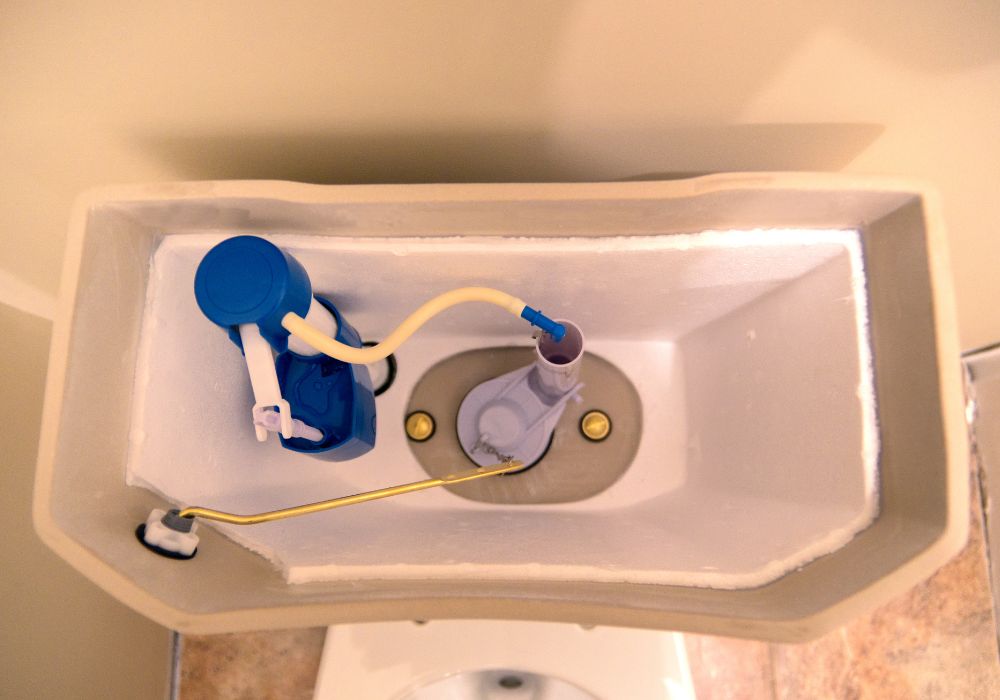Maintenance and regular cleaning of the toilet tanks is other aspects you must consider. However, they can be a hassle, and it takes much more time to properly clean the toilet tank than the toilet bowl or even the toilet walls.
But what can you put in your toilet tank to keep the water flowing to your toilet bowl clean and free of odors?
The best home DIY toilet tank cleaning solution you can use is a combination of borax and vinegar. You must leave a couple of inches inside the toilet tank before pouring the solution. Scrub the insides of the toilet and flush the water off.
In this article, I will present you with other alternatives that can clean and maintain your tank and keep them free of bacteria.
What Can I Put In My Toilet Tank To Keep The Bowl Clean?

You can use commercial bathroom solutions like toilet bowl cleaners or toilet tablets to make cleaning easier.
But if you are uncomfortable using them due to harsh chemicals and strong odor.
But the good news is that better alternative DIY cleaning solutions exist, such as combining borax and vinegar.
However, there are other options available you can use as well. You have to follow the following guidelines using the said home essentials.
Firstly, we have to list the items you need for the cleaning processes:
- White vinegar
- Borax
- Dishwashing soap liquid
- Baking soda
- Hand rubber gloves
- Toilet bristle brush
Now, the following is the step-by-step guideline you have to follow in cleaning the toilet tank properly.
Vinegar Solution
Before proceeding to the cleaning process, you must turn off the water supply first. And then, remove the water from the toilet but leave about an inch.
So how much vinegar do you need to clean a single toilet tank? For this purpose, you may need 3 to 7 gallons, depending on the toilet tank size.
Pour the vinegar and leave it there for approximately 12 to 13 hours. But before draining the vinegar, brush the insides of the toilet tank first, especially where the molds and rusts are.
Baking Soda and Vinegar Scrub
You can use a combination of vinegar and baking soda for faster cleaning. Drain the toilet tank’s water up to an inch or as long as it covers the molds or rusts.
Pour 2 tablespoons of dishwashing soap, liquid, and vinegar inside the toilet tank. And then, add ½ cup of baking soda. Mix the solution, then scrub all the sides of the toilet tank until they are clean and free of molds and rust.
Leave the solution for about an hour before you scrub the toilet tank again. Flush the water and turn on the water system. Flush the water again to rinse the toilet tank.
Vinegar and Borax
Borax Powder – Multi-Purpose Cleaner from Amazon
Borax and vinegar is the most popular DIY toilet tank cleaner because it uses borax, eliminating rust and mold that formed over time.
Similar to the previous solutions, remove water and leave about an inch. However, you may have to leave enough water to cover where there is the presence of rust and mold.
Mix 4 cups of vinegar and 1 cup of borax. Stir the solution and scrub the insides of the toilet tank thoroughly.
And then, leave the solution to sit there for about 1 to 2 hours before you flush them completely and rinse the residue.
Turn the main water system on and allow the water to fill the toilet tank. Flush the water several times until you completely get rid of the residue.
Vinegar and Bleach
Bleach is not as popular as borax because it emits a strong odor. In addition, bleach has harsh chemicals that could irritate the skin under prolonged exposure.
However, suppose the molds and rusting are severe, especially if there’s an overgrowth of fungi and bacteria. In that case, bleach is a good excuse to remedy your toilet tank issue.
Also, you may need additional equipment, such as goggles and a face mask, because the combination of vinegar and bleach releases fumes that are toxic to humans.
The previous method of removing water up to an inch still applies to this method. However, you can pour vinegar and bleach according to your preference as long as it eliminates the overgrowth of fungi and rust.
Do Toilet Tank Tabs Work?
You can use regular cleaning solutions such as a toilet tab if you don’t have the time to clean the toilet extensively. But the question that you may have is if they work.
Toilet tabs won’t 100% keep your toilet, but they can somehow reduce bacteria-causing molds in your toilet tanks.
In addition, you will find varieties of toilet tabs that produce different colors and pleasant odors that keep your toilet smelling fresh.
What Is the Best Toilet Tank Cleaner?
Vinegar and baking soda are your home’s best non-commercial toilet tank cleaners. Both compounds are tough on bacteria but do not have harsh chemicals that could harm humans.
If you are not keen on using DIY toilet tank cleaners, there are brands of toilet cleaning solutions that do not have harsh chemicals yet are effective in getting rid of bacteria and bad odors.
Some of the best toilet tank cleaners that you have to try are as follows:
- Clorox Toilet Bowl Cleaner
- Domex Automatic Toilet Bowl Cleaner
- Better Life Natural Toilet Bowl Cleaner Tea Tree and Peppermint
- Domex Professional Toilet and Bathroom Cleaner
- Lysol Automatic Toilet Cleaner
- Cif Antibacterial Cream Cleanser Lemon
- Mr. Muscle In-Tank Block Automatic Toilet Bowl Cleaner
What Can I Use To Clean My Toilet If I Have a Septic Tank?
You can use regular bathroom cleaning agents to clean the septic tank. But you can also use baking soda and vinegar.
The advantages of these compounds are that they do not have harsh chemicals and are safe as you clean the septic tank.
But as mild as they are, they effectively eliminate bacteria and fungi overgrowth.
FAQ
Will Vinegar Damage the Toilet Tank?
No. Vinegar will not damage your tank. Although the compound is acidic, they are mild and effective in removing rust and molds.
How Do I Keep My Toilet Smell Fresh?
To keep your toilet fresh, you have to clean the room regularly. You can also use toilet tablets or air fresheners to remove bad and unpleasant odors.
Can I Put Baking Soda In The Toilet Tank?
Yes. Although baking soda creates a foamy consistency when mixed with vinegar or water, they are highly soluble that goes down the drain after you flush them.











